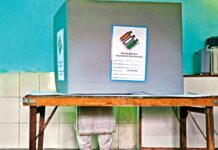The residents of Faridkot receive water after a gap of 10 days.
CHANDIGARH: It was on July 23 2019, when the Aam Aadmi Party (AAP) MLA from the Kotkapura constituency reached the Deputy Commissioner of Faridkot, Kumar Saurabh Raj, with a bottle filled with black, contaminated water. The situation has not changed a bit; the same brackish, stinking water is still being supplied to the people of Faridkot and Kotkapura. Faridkot, often hailed as the nursery of Punjab politics, now finds itself at a crossroads of broken promises and an escalating water crisis. From the days of Giani Zail Singh to Parkash Singh Badal, and now with the emerging political face of Kultar Singh Sandhwan, the district has been home to many prominent leaders who rose through its political ranks. These leaders, once campaigning for the betterment of the people, especially in areas concerning potable water, now seem distant from the plight of their citizens. Faridkot is not just a geographical location; it is a political symbol in Punjab. The district, named after the Sufi saint Sheikh Farid, has been the cradle of political careers that shaped the state’s destiny. It was here that many politicians made their first mark, riding high on issues that mattered most to the people—issues like water supply. However, once these politicians reached the heights of power, the very district that nurtured their careers became a victim of neglect. More mouths than water situation: As of 2025, Faridkot has an approximate population of 3.5 lakh people, while Kotkapura, a key town within Faridkot district and the constituency of the Punjab Vidhan Sabha Speaker, has a population of around 1.2 lakh people. Despite the district’s significant political influence, the crisis that has plagued its water supply remains unresolved. The residents of the entire Faridkot district now receive water after a gap of 10 days, for a brief half hour, and when the supply finally comes, it is filthy, brackish, and contaminated. Adding to the grim reality, on 23rd April 2025, residents of Faridkot city and Kotkapura staged a massive protest demanding clean drinking water. Citizens, including students, shopkeepers, women, and elderly residents, gathered outside the Municipal Council office under the banner of Jal Jeevan Bachao Manch. Holding black water bottles in their hands, they raised their voices against the contaminated water being supplied to them. They accused the local administration of distributing sewer-mixed water, unfit for human consumption, and warned that if immediate steps were not taken, they would intensify their protests. Social organisations also joined the movement, calling for urgent action on the water crisis. According to Shankar Sharma, Co-Convener of Jal Jeevan Bachao Manch, “The tale of Faridkot’s water crisis is a bitter one. Political leaders who once walked door-todoor, holding water bottles and waving reports on the dangerous contaminants in the district’s water supply, are now eerily silent.” Sharma pointedly mentioned Kultar Singh Sandhwan, Speaker of the Punjab Vidhan Sabha and a familiar face in Punjab politics, for not walking the talk. Sandhwan had once carried a water report in one hand, declaring that Faridkot’s water was unsafe for consumption due to uranium, nitrates, and heavy metals. On the other hand, he held a brush smeared with red paint, marking hand pumps across the city to warn people of the imminent health risks—cancer, asthma, and tuberculosis—if they consumed the contaminated water. He had then called for a mass movement to save Faridkot’s water from being sold off to Rajasthan. People, with high hopes, believed in these leaders, thinking they would be the saviours of the district. They voted these leaders into power, trusting their promises for clean drinking water, Sharma said. Shankar, while speaking to The Sunday Guardian, stated that, in an ironic twist, the same leaders who once stood for the protection of water and the environment are now responsible for policies that have worsened the situation. In their quest for development, they have sealed canals with concrete, disrupting the natural recharge system that once allowed the earth to absorb and purify water. The people, including farmers, shopkeepers, students, and workers, who once fought alongside their leaders for their rights, now find themselves fighting the very same leaders to restore their basic right to clean water. According to Shankar, there is either no water treatment plant in the district or the existing ones are nonfunctional. Shankar told The Sunday Guardian that the officers in question had already shown their inefficiency in managing this menace. The Sunday Guardian spoke with Kultar Singh Sandhwan on the matter; Sandhwan reiterated that a Rs 12 crore tender is going to be floated soon for waterrelated works and assured that people will soon receive clean water. However, for many, these promises no longer hold weight, as they have seen such pledges made—and forgotten—before. The water situation in Faridkot and Kotkapura has shown no improvement. The same contaminated water, mixed with sewage, continues to be supplied to residents. Despite the large-scale protests and mounting pressure on the local administration, no concrete steps have been taken to address the core issue.








